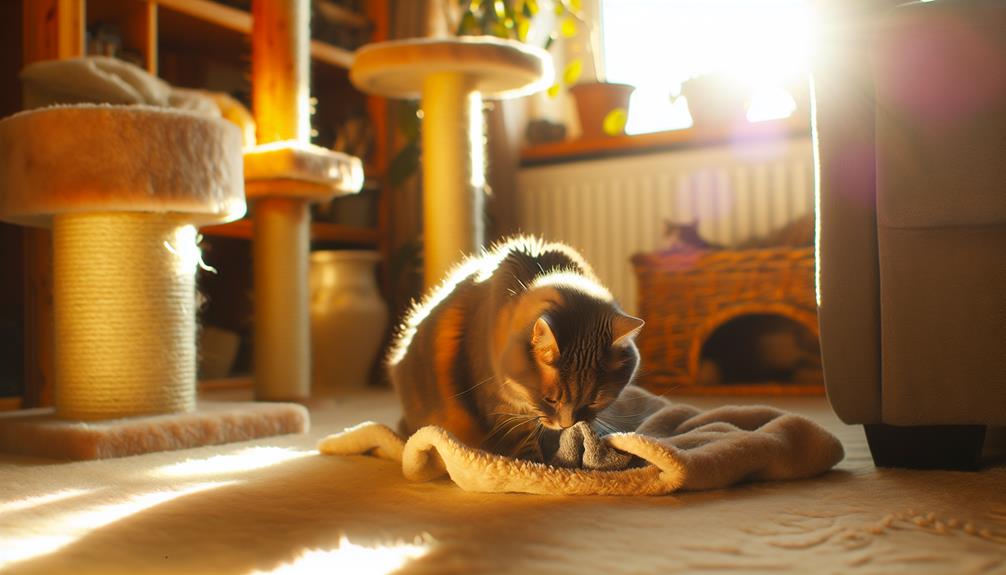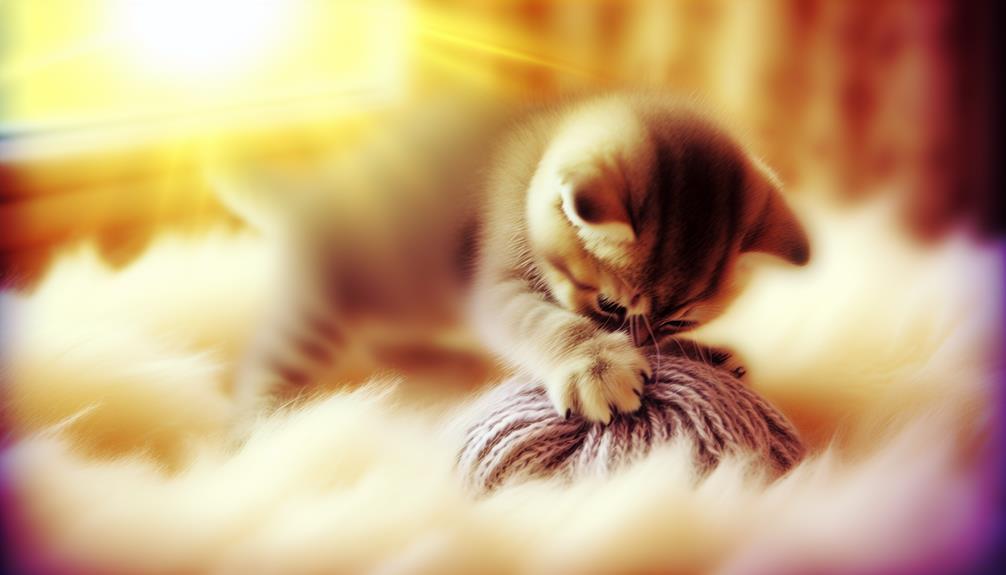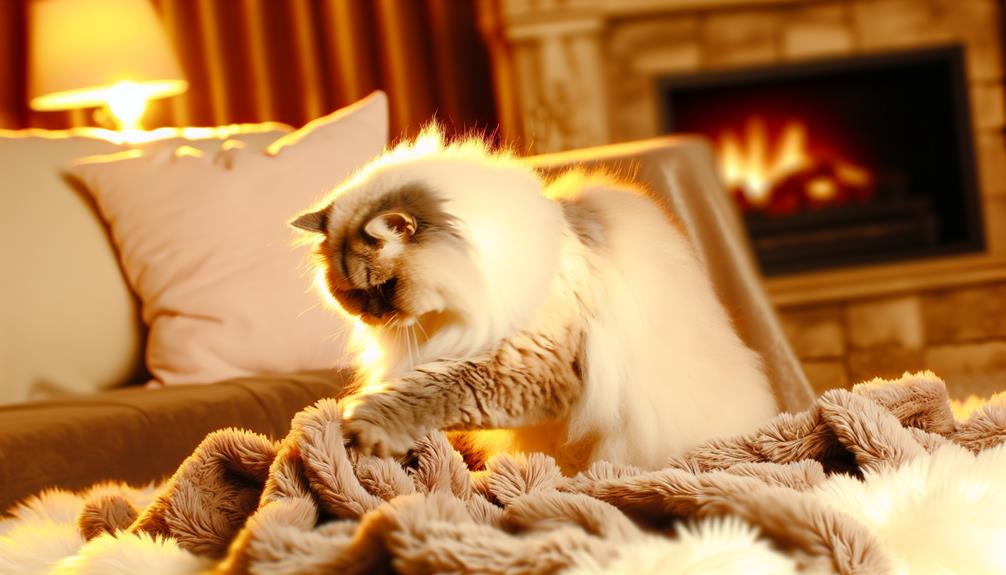You've probably noticed your cat kneading soft surfaces, a behavior often referred to as "making biscuits." This seemingly peculiar action is rooted in instinct and serves multiple purposes, from providing comfort and marking territory to preparing cozy resting spots. But did you know it also harks back to their time as kittens, when kneading helped stimulate their mother's milk? Understanding why cats make biscuits can deepen your appreciation for these fascinating creatures. Curious about the other reasons behind this behavior and what it might mean for your relationship with your furry friend? Let's explore further.
Instinctual Behavior
When cats engage in "making biscuits," they're demonstrating an instinctual behavior rooted in their early development. This action, characterized by the rhythmic kneading of their paws against soft surfaces, is deeply embedded in feline psychology. From a clinical perspective, this repetitive motion originates from their time as kittens. Newborn cats knead their mother's belly to stimulate milk flow, an essential survival mechanism. This ingrained behavior often persists into adulthood, reflecting the evolutionary traits of domestic felines.
Understanding these evolutionary traits is significant for interpreting why your cat continues to knead. Wild feline ancestors utilized kneading for various purposes, such as creating a soft, comfortable nesting area. This behavior has been carried over to domestic cats, although the context has shifted. The kneading motion is a manifestation of a deeply rooted instinct, suggesting that certain primal behaviors are conserved across generations.
Comfort and Security
You may observe that cats knead as a manifestation of comfort and security. This behavior originates from instinctual nesting and is reinforced by early mother-child bonding activities. Additionally, kneading serves as a stress relief technique, helping cats manage anxiety.
Instinctual Nesting Behavior
Instinctual nesting behavior in cats, often referred to as "making biscuits," is a deeply ingrained action that provides them a sense of comfort and security. This behavior involves playful kneading and rhythmic motion, often observed in both domestic and wild felines. When your cat engages in this activity, it's not merely a random act but a complex, instinctual behavior with specific purposes.
| Behavior | Purpose |
|---|---|
| Playful kneading | Comfort and relaxation |
| Rhythmic motion | Security and territory marking |
| Flexing paws | Muscle exercise |
| Repetitive action | Stress relief |
Playful kneading involves alternating paw movements that mimic the rhythmic motion observed in kittens. This action is believed to stimulate the release of endorphins, providing a soothing effect. The rhythmic motion also helps cats mark their territory, as their paws have scent glands that leave a unique scent on the surface they knead.
Understanding this behavior can help you provide an environment that maximizes your cat's comfort and sense of security. Guarantee that they have soft surfaces to knead on and consider this behavior as a sign of a content and relaxed feline. Observing these actions can give you insight into your pet's well-being and emotional state.
Mother-Child Bonding
The bond between a mother cat and her kittens is a profound example of comfort and security within feline behavior. This maternal behavior is pivotal in the early development of kittens, providing them with essential nurturing instincts and socialization cues. Through playful interactions, the mother cat engages in feline communication that helps her offspring develop emotional intelligence and understand complex behavioral patterns.
During the initial weeks, kittens rely heavily on sensory exploration to navigate their environment. The mother's constant presence offers a secure base, reinforcing feline attachment and promoting a sense of safety. Her nurturing instincts guide her actions, such as grooming and nursing, which are critical for the kittens' physical health and emotional well-being.
Feline communication between the mother and her kittens includes vocalizations, tactile signals, and visual cues. These interactions are instrumental in teaching the kittens how to interact within their social group. Maternal behavior also includes protective actions, ensuring that the kittens are safe from potential threats.
Stress Relief Technique
Many cat owners have observed their feline companions kneading, or "making biscuits," on soft surfaces. This behavior serves as a stress relief technique, promoting comfort and security for the cat. The rhythmic kneading, often accompanied by purring therapy, is a form of feline relaxation. This soothing behavior can induce a state of feline mindfulness, allowing the cat to focus on the repetitive motion and purring, thereby facilitating emotional release and stress reduction.
The calming ritual of kneading is not merely a playful instinct but also a significant aspect of a cat's happiness expression. During this activity, the cat engages in a form of self-soothing, which can help mitigate anxiety and promote a sense of well-being. This behavior is akin to humans using mindfulness techniques to achieve relaxation and stress relief.
As a cat kneads, it often enters a state of contentment and security, which can be observed through its relaxed posture and gentle purring. This activity is essential for the cat's emotional health, providing a reliable method for managing stress and enhancing overall feline well-being. Understanding this behavior can help cat owners facilitate an environment conducive to their pet's comfort and happiness.
Marking Territory

Cats engage in the behavior of kneading, often referred to as "making biscuits," as a method of marking their territory. This action serves as a form of territorial signaling, allowing cats to communicate ownership over a particular area. When a cat kneads, it engages in scent marking by releasing pheromones from glands located in its paws. This scent marking is a subtle yet effective way to signal presence and establish an instinctual claim over its environment.
Kneading also functions as a dominance display. By marking a specific area, a cat asserts its authority and reinforces its territorial boundaries. This behavioral communication is vital for maintaining social order among multiple cats or other pets in a household. Through these actions, cats convey their dominance and stake a claim on essential resources like food, sleeping spots, and human attention, a behavior known as resource guarding.
Environmental familiarity plays a significant role in a cat's inclination to knead. By repeatedly marking the same spot, a cat enhances its sense of security and comfort within its surroundings. This territory reinforcement helps the cat feel more at ease, reducing anxiety and promoting a stable living environment.
Preparing Resting Spots
Kneading behavior often serves as a preparatory action for creating comfortable resting spots. When your cat engages in this rhythmic, back-and-forth motion, it's likely they're attempting to make their sleeping environment more agreeable. This behavior can be traced back to their wild ancestors, who would knead grass or leaves to create a softer, more insulated resting area.
To enhance their resting spots, cats may have specific preferences related to:
- Pillow preferences: Some cats are particularly fond of certain types of pillows, which can range from firm to soft. Observing your cat's pillow preferences can provide insights into their comfort needs.
- Favorite fabrics: Cats often select areas with textures they find soothing. Fabrics like fleece, cotton, or wool might be favored due to their warmth and softness.
- Temperature regulation: By kneading, cats might also be trying to adjust the temperature of their resting spot. The action can create a slight indentation, which may help to trap heat in cooler environments or disperse it in warmer ones.
- Scent marking: While primarily a behavior for marking territory, the act of kneading can also help transfer their scent to their chosen resting spot, reinforcing a sense of security.
Understanding these aspects can help you provide the best resting environment for your feline friend. By observing your cat's kneading behavior and preferences, you can make informed decisions about the types of bedding and materials to offer. This guarantees their resting spots align with their natural instincts and comfort requirements, thereby promoting better sleep and overall well-being.
Weaning Memories

The behavior of kneading often traces back to a cat's early life experiences, particularly the weaning process. During the critical weaning stages, kittens shift from mother's milk to solid food. This period is laden with significant sensory experiences that shape their future behaviors. When nursing, kittens instinctively knead their mother's belly to stimulate milk flow. This rhythmic motion, coupled with the warmth and security of the mother, forms a deeply ingrained association.
As you observe your cat kneading, it's fundamentally reliving those comforting moments from its weaning stages. The tactile sensation of pressing its paws against a soft surface might replicate the feeling of its mother's fur and the satisfying milk flow. These sensory experiences are not just physical but also emotional, embedding a sense of comfort and security that persists into adulthood.
Kneading becomes a behavioral remnant of this formative period. For some cats, the act is almost a subconscious return to those early days, a self-soothing mechanism that taps into their primal instincts. While the weaning process typically concludes by the time a kitten is eight weeks old, the behavior of kneading can last a lifetime, serving as a bridge between past and present.
Understanding this connection helps explain why kneading is such a ubiquitous behavior among domestic cats. It's a complex interplay of early developmental stages and sensory experiences that leaves a lasting imprint. By recognizing these weaning memories, you gain insight into your cat's behavior, revealing how deeply rooted and significant these early life stages are.
Sign of Affection
When your cat makes biscuits, it's not just a random behavior; it's a clear sign of affection. This action helps them bond through touch, providing comfort and security. Observing this can indicate that your cat feels a strong sense of trust and attachment to you.
Bonding Through Touch
Cats often engage in kneading as a way to bond through touch, displaying a profound sign of affection. This tactile engagement is a multifaceted behavior involving several elements of feline communication. When your cat kneads, it's not just about the physical movements; it's also about the purring vibrations that often accompany this activity. These vibrations serve as an emotional connection, enhancing the touch sensitivity between you and your pet.
- Sensory Exploration: Kneading allows cats to explore different textures, increasing their sensory awareness.
- Social Bonding: Through this action, cats establish and reinforce their bond with you, akin to mutual grooming in the wild.
- Warmth Sharing: The warmth your cat feels and shares during kneading promotes a sense of security and comfort.
- Playful Interactions: Kneading can evolve into playful interactions, further strengthening your relationship.
Kneading also serves as a form of social bonding, reminiscent of the mutual grooming behaviors observed in feline groups. This behavior fosters a deep emotional connection and is integral to the cat's tactile engagement with its environment. By understanding these nuances, you can better appreciate the intricate ways in which your cat communicates affection and seeks to maintain a connection with you.
Comfort and Security
Although it might seem simple, kneading is intricately tied to a cat's sense of comfort and security, serving as a profound sign of affection. This behavior is rooted in their nurturing instincts, often observed during quiet moments with their favorite humans. When your cat kneads, they are creating safe spaces, mimicking the cozy environments they experienced as kittens.
| Aspect | Description |
|---|---|
| Safe Spaces | Kneading generates a familiar, secure area |
| Emotional Connection | Reinforces the bond between cat and owner |
| Playful Interactions | Often accompanies light, playful behaviors |
| Purring Sounds | Enhances the feeling of safety and contentment |
| Sensory Experiences | Stimulates tactile and olfactory senses |
The purring sounds that accompany kneading amplify the sense of security. These feline rituals are essential relaxation techniques, allowing your pet to create a tangible emotional connection with you. The rhythmic motion can be seen as a form of self-soothing, turning stressful situations into moments of tranquility.
In addition, kneading is a form of sensory experience for cats. The repetitive pressure applied by their paws can also mark territory through scent glands, further enhancing their feeling of safety. By understanding these behaviors, you can better appreciate the complexities of your cat's actions and their underlying meanings.
Conclusion
In summary, when your cat makes biscuits, it's weaving together threads of instinct, comfort, and connection. This age-old behavior, a tapestry of weaning memories and territorial markings, not only provides your feline friend with a sense of security but also strengthens the emotional bond between you. So, the next time you see your cat kneading, know it's not just an action—it's a heartfelt symphony of their primal past and present comfort.
